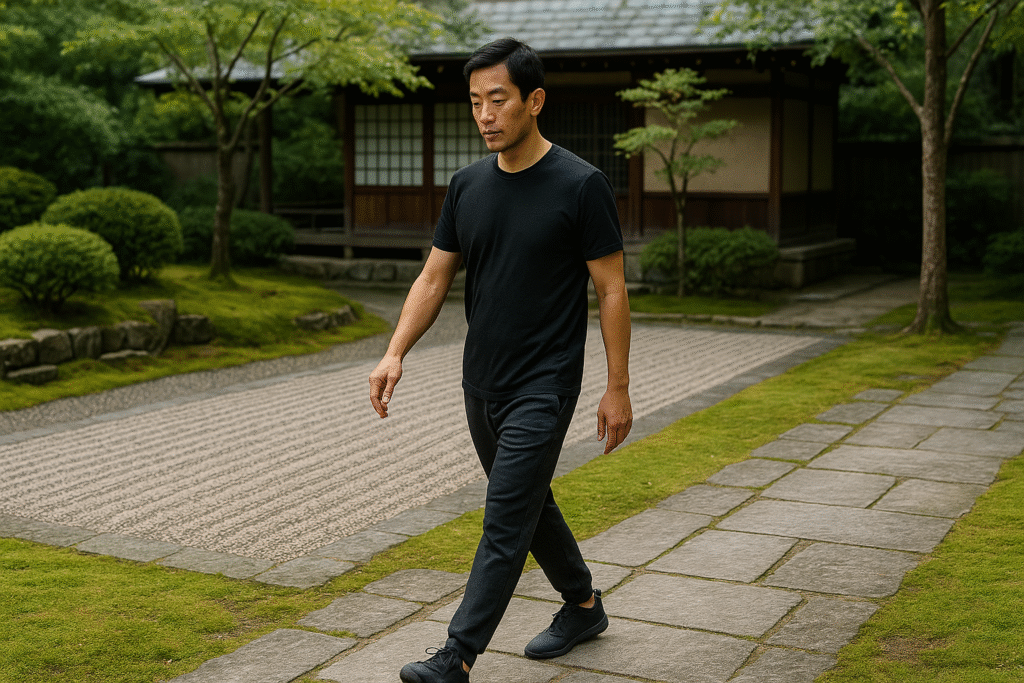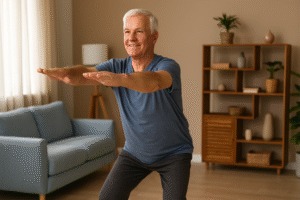Every year, new fitness trends flood social media, promising better health with minimal effort. But while many fads fade fast, one time-tested habit from Japan is quietly gaining global attention: Japanese walking. Unlike the rigid “10,000 steps a day” rule, this holistic movement approach combines rhythm, posture, and breath—offering a more balanced and mindful path to wellness.
Rooted in centuries-old traditions, Japanese walking emphasizes how you walk, not just how far. From the graceful Namba Aruki style used by samurai couriers to modern slow-walking therapy embraced by Japanese wellness communities, this approach supports posture, stress relief, and joint longevity in ways traditional step counts simply can’t match.
In this article, we’ll explore how Japanese walking outpaces the 10,000-step obsession, uncover its cultural roots, and show you how to integrate its principles into your daily routine. If you’re ready to rethink your fitness goals and discover a more natural, effective way to move, keep reading.
The Origins of Japanese Walking: A Cultural Legacy of Movement
Walking in Japan isn’t just transportation—it’s a refined cultural practice rooted in centuries of mindfulness, physical alignment, and efficient energy use. Unlike Western walking habits, which often emphasize speed or calorie burn, traditional Japanese walking styles prioritize body awareness, rhythm, and the environment.
The Historical Roots of Namba Aruki
One of the most iconic walking styles in Japan is Namba Aruki—a technique once practiced by samurai messengers and rice carriers. The method is deceptively simple: the same-side arm and leg move together, rather than the opposite-side coordination typical in modern walking.

This movement pattern may seem unnatural at first, but studies of ancient scrolls and martial arts techniques suggest Namba Aruki minimized energy use and allowed for better balance under load. Researchers from the University of Tokyo have analyzed how this method conserved core strength and prevented overuse injuries among long-distance couriers.
Quick TipTry walking with your left arm and left leg moving forward together—it feels strange, but improves core engagement and coordination.
The Influence of Zen and Natural Alignment
Japanese walking is often influenced by Zen principles, emphasizing calm, awareness, and integration with one’s surroundings. Traditional practices such as kinhin (walking meditation) teach practitioners to move slowly and deliberately, syncing breath with step. This cultivates:
- Mindfulness in motion
- Lowered stress response
- Improved posture and spinal alignment
Rather than viewing walking as a goal-driven exercise, Zen walking turns it into a holistic wellness ritual—engaging the mind just as much as the body.
Walking in Harmony with Nature: Urban vs. Rural Japan
In Japan, both urban dwellers and countryside residents incorporate walking into daily life. From walking to train stations in cities like Osaka to leisurely strolls through Kyoto gardens, movement is seamlessly woven into daily routines. Sidewalks and parks are designed with nature, pace, and quiet in mind—fostering a walking culture that encourages long-term health.
Did You Know?In Japan, walking is one of the most common modes of transportation—over 40% of citizens walk more than 6,000 steps daily without even trying.
How Modern Japan Preserves These Traditions
Today, wellness programs in Japan continue to draw from traditional walking. Senior health initiatives often include slow, guided walking routines to maintain balance and prevent falls. Meanwhile, wellness spas promote walking barefoot on textured paths to stimulate foot reflex zones and improve circulation.
Expert SummaryJapanese walking practices combine biomechanics, historical tradition, and Zen principles to offer a uniquely holistic movement experience—one that goes beyond step counts or calories burned.
Why 10,000 Steps May Not Be the Gold Standard After All
For decades, the health and fitness world has pushed the “10,000 steps a day” goal as a universal benchmark. But did you know this number didn’t originate from science? It started as a marketing slogan in Japan during the 1960s by a pedometer manufacturer (Manpo-kei literally means “10,000-step meter”). Despite its popularity, new research suggests that step count alone doesn’t guarantee better health.
The Scientific Case Against Step Obsession
Recent studies, including one published in JAMA Internal Medicine, have found no significant difference in mortality rates between those who walk 7,000 steps and those who hit 10,000. In fact, movement quality, not just quantity, plays a greater role in long-term well-being.
According to Harvard Medical School, slow, mindful walking may help reduce inflammation markers, regulate blood pressure, and even boost immune function—especially when paired with intentional breathing and proper alignment.
👉 NIH study on walking pace and mortality risk
The Downsides of Rigid Step Targets
While 10,000 steps can be a helpful motivator, it can also lead to:
- Overexertion for beginners or the elderly
- Misleading progress for those walking aimlessly without posture or purpose
- Neglect of recovery, especially if you’re forcing steps despite fatigue
By contrast, Japanese walking traditions emphasize sustainable movement that adapts to the individual’s physical condition and rhythm.
Quick TipInstead of chasing arbitrary numbers, track how you feel after walking: Are you more focused? Breathing better? Less tense?
How Japanese Walking Fills the Gaps
Japanese walking focuses on form, flow, and functional benefit. This style:
- Prioritizes posture and joint safety over distance
- Incorporates natural breaks, pausing at shrines or scenic spots
- Cultivates a meditative mindset through rhythmic breathing and environmental awareness
These elements foster parasympathetic nervous system activation, reducing stress far more effectively than hurried, disconnected walking just to meet a goal.
Did You Know?The 10,000-step trend is based on a 1965 Japanese pedometer ad—not medical science. Studies show benefits begin around 7,000.
The Role of Consistency Over Intensity
From Tokyo commuters to Okinawan elders, daily movement in Japan is less about high intensity and more about habitual, low-impact activity. This aligns with findings from the Blue Zones research, which shows that longevity correlates with natural movement throughout the day, not sporadic bursts of exercise.
➡️ For example, the Okinawan practice of ikigai—having a sense of purpose—is often expressed through daily walks to community gardens, fostering both mental and physical health.
Expert SummaryEmerging science shows that walking quality, mental presence, and adaptability matter more than arbitrary step counts—reinforcing what Japanese traditions have known for centuries.
The Science-Backed Benefits of Japanese Walking
Japanese walking isn’t just cultural—it’s physiological. When analyzed through the lens of modern biomechanics and neuroscience, its benefits become evident: improved posture, reduced joint strain, enhanced brain function, and even better metabolic health. Unlike conventional walking routines, Japanese walking invites the whole body and mind to participate, amplifying results.
Posture, Core Strength, and Joint Longevity
A defining feature of Japanese walking is the alignment of the spine, hips, and feet. Walking with a centered posture—heels softly landing, pelvis neutral, and shoulders relaxed—engages the deep core muscles more efficiently than modern brisk walking.
According to a 2022 study published in Gait & Posture, slower, deliberate walking styles reduce impact stress on knees and hips by up to 23%, making it ideal for aging populations or those recovering from injury.
🧠 What the Research SaysA University of Tsukuba study found that participants using Namba walking patterns improved their pelvic stabilization and decreased spinal compression loads after only 4 weeks.
Mental Clarity and Stress Regulation
Japanese walking often includes breath control and environmental mindfulness, similar to walking meditation. This has a direct impact on the autonomic nervous system, specifically by increasing parasympathetic (rest and digest) activity.
In fact, walking meditation techniques like kinhin have been shown to:
- Lower cortisol levels
- Improve heart rate variability (HRV)
- Decrease rumination and anxiety
These benefits echo findings from Harvard Medical School, which show that even 15 minutes of mindful walking can significantly reduce acute stress levels.
Did You Know?Japanese walking often includes silent, nature-based paths that activate both hemispheres of the brain—boosting memory and creativity.
Balance, Coordination, and Fall Prevention
One of the most overlooked fitness metrics is balance—especially in older adults. The rhythmic, symmetrical nature of Japanese walking encourages even weight distribution and neuromuscular activation.
A clinical trial in 2021 published in Frontiers in Aging Neuroscience found that seniors practicing slow, controlled walking with posture cues showed:
- 37% improvement in single-leg balance
- Faster reaction times during stability challenges
- Lower fall rates over 6 months
These results are being applied in elder care centers in Japan, where Japanese walking forms a pillar of preventative wellness programs.
Boosted Metabolism and Circulatory Function
Although not as intense as high-intensity workouts, Japanese walking creates consistent low-intensity exertion—often for longer periods, especially when walking is embedded into daily activities.
➡️ Pairing Japanese walking with natural fat-burning aids, such as HepatoBurn, can further support metabolic health and liver function, especially for those struggling with slow weight loss.
Expert SummaryStudies confirm Japanese walking improves balance, reduces stress hormones, and supports joint longevity—making it more than just a form of cardio.
How to Practice Japanese Walking: A Step-by-Step Approach
While Japanese walking may seem subtle, it requires awareness, patience, and control. This isn’t about speed or distance—it’s about precision, posture, and rhythm. Whether you’re walking in your neighborhood or during a break at work, here’s how to make every step count using the Japanese method.

Step 1: Reset Your Posture
Before you move, align your body. Imagine a string pulling the top of your head upward. This vertical axis is central to Japanese movement forms like aikido and taiko drumming.
- Feet shoulder-width apart, pointing straight ahead
- Knees relaxed, not locked
- Pelvis in neutral, not tilted
- Shoulders dropped away from ears
- Chin tucked slightly, eyes gazing ahead
Stand near a wall to check your alignment—your heels, buttocks, shoulders, and back of head should all touch lightly.
Step 2: Engage Namba Aruki (Same-Side Motion)
This step is what defines traditional Japanese walking. Instead of the usual cross-limb movement (left leg with right arm), you move the left arm with left leg, and right arm with right leg. This synchronized motion encourages core stability and internal body awareness.
- Walk slowly at first
- Keep your steps short and soft
- Allow arms to swing gently with the same leg
This motion minimizes torsional stress on the spine and keeps your center of gravity low and controlled.
Did You Know?Namba walking was used by samurai and porters to cover long distances with heavy loads without fatigue.
Step 3: Sync with Your Breath
Breathing is key in Japanese movement disciplines. With each step, inhale through your nose and exhale slowly through your mouth. Aim for 4 steps per full breath cycle.
- Inhale (2 steps) – feel expansion in ribs
- Exhale (2 steps) – soften shoulders and jaw
This practice enhances oxygen efficiency, helps regulate the nervous system, and promotes mental clarity.
Step 4: Integrate Environmental Awareness
Japanese walking isn’t internalized isolation—it’s about connection with your environment. Pay attention to:
- Sounds (leaves rustling, footsteps)
- Smells (earth, plants, urban surroundings)
- Textures under your feet
- Visuals without fixation—scan gently
This stimulates neuroplasticity and multi-sensory integration, key components of brain health and cognitive longevity.
What the Research SaysMultisensory walking practices increase gray matter volume in brain regions associated with focus and memory (source: NIH Cognitive Health Division).
Step 5: Apply It Daily
The final step is making Japanese walking part of your daily rhythm. Start with 5–10 minutes and build up to 30 minutes, especially during:
- Morning routines
- Post-lunch energy slumps
- Evening wind-downs
- Short walking breaks at work
For an added boost, pair your walks with targeted nutrient support from this guide on micronutrients to maximize recovery, energy, and hormonal balance.
Expert SummaryJapanese walking is a low-barrier, high-benefit practice. Mastering alignment, breath, and rhythm transforms everyday steps into therapeutic movement.
Japanese Walking vs. Other Fitness Trends: What Makes It Unique
In today’s crowded wellness landscape, it’s easy to feel overwhelmed by the choices: HIIT, hot yoga, CrossFit, intermittent sprinting… Yet, amidst all the high-intensity trends, Japanese walking offers a calm, sustainable, and highly effective alternative. But how exactly does it compare?
Japanese Walking vs. HIIT (High-Intensity Interval Training)
HIIT is known for its calorie-burning and cardiovascular benefits, but it also comes with risks:
- Joint stress and injury potential
- Overtraining and adrenal fatigue
- Accessibility limitations for seniors or beginners
By contrast, Japanese walking supports long-term movement health without burnout. It activates the parasympathetic nervous system, enhancing recovery and hormonal balance.
➡️ Learn more about how HIIT works and its limitations in our detailed guide:
The Science Behind HIIT: Burn Fat Faster
Japanese Walking vs. Traditional Walking
Standard walking is often promoted through fitness trackers and mobile apps, but it typically lacks emphasis on:
- Posture correction
- Breathing techniques
- Mind-body synchronization
Japanese walking refines all three. Even walking 3,000–5,000 steps in the Japanese style may outperform 10,000 disorganized steps in terms of cardiovascular benefit and neuromuscular engagement.
Did You Know?Slow, deliberate walking can increase cardiovascular efficiency and metabolic output—even more than casual walking with poor posture.
Japanese Walking vs. Running and Jogging
While running builds endurance, it also generates repetitive impact on the knees and spine. Japanese walking offers:
- Lower impact, preserving joint integrity
- Better gait control, especially for those with previous injuries
- Increased proprioception, helping prevent future injuries
A study in The American Journal of Sports Medicine found that over 65% of recreational runners report annual injuries—many due to gait imbalances that walking styles like Namba Aruki help correct.
Japanese Walking vs. Yoga and Tai Chi
Yoga and tai chi share elements of mindful movement, breathwork, and alignment—but they are typically practiced in place. Japanese walking brings similar benefits into mobile motion, making it more applicable to daily routines.
It also activates the vestibular system and spatial awareness more robustly due to constant forward movement and environmental feedback.
Expert SummaryJapanese walking blends biomechanics, mindfulness, and natural movement in ways no other fitness trend can replicate—making it uniquely sustainable and impactful.
Conclusion
Japanese walking offers more than just physical movement—it’s a holistic experience that nurtures posture, breath, and awareness. Unlike the rigid and often stressful 10,000-step paradigm, this traditional practice fosters long-term wellness through mindful, biomechanically sound walking.
Backed by science and centuries of Japanese tradition, this method supports not only your joints and muscles but also your nervous system and cognitive health. Whether you’re seeking to improve your balance, reduce stress, or enhance your metabolic function, Japanese walking is a gentle yet powerful tool worth adopting.
By walking with intention—not just steps—you invite transformation into your everyday life.
Main Takeaways
- Japanese walking emphasizes quality of movement over quantity of steps.
- Namba Aruki promotes core engagement, joint safety, and energy efficiency.
- Mindful walking improves stress response and boosts brain function.
- Scientific studies confirm its benefits for posture, balance, and longevity.
- It integrates seamlessly into daily routines—making wellness sustainable.
Japanese Walking vs. Other Fitness Methods
| Fitness Method | Impact on Joints | Mental Health Benefit | Ease of Daily Integration |
|---|---|---|---|
| Japanese Walking | Very Low | High (breath, mindfulness) | Excellent |
| HIIT | High | Moderate | Low (requires planning) |
| Traditional Walking | Low | Low | Good |
| Running | High | Low | Moderate |
| Yoga/Tai Chi | Very Low | High | Moderate (requires space) |
Want to enhance your walking routine with essential nutrients? Micronutrients Guide: Why Your Body Needs More Than Just Exercise Further Reading:
Looking for a natural fat-burning companion to pair with your walks? HepatoBurn Review: Detox and Burn Fat the Smarter Way








One Response